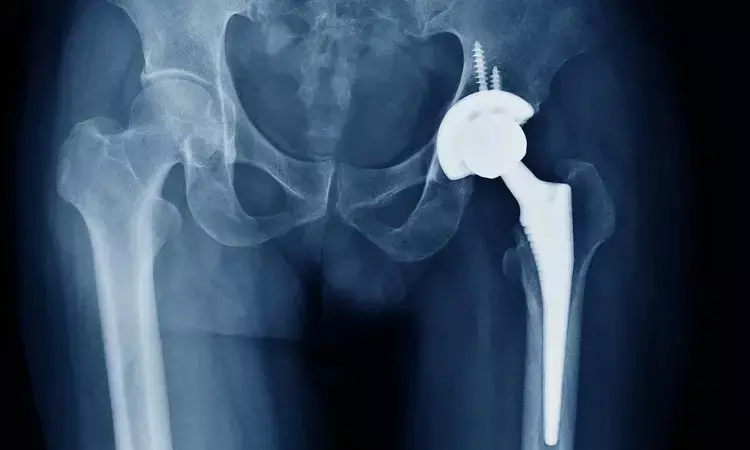- Home
- Medical news & Guidelines
- Anesthesiology
- Cardiology and CTVS
- Critical Care
- Dentistry
- Dermatology
- Diabetes and Endocrinology
- ENT
- Gastroenterology
- Medicine
- Nephrology
- Neurology
- Obstretics-Gynaecology
- Oncology
- Ophthalmology
- Orthopaedics
- Pediatrics-Neonatology
- Psychiatry
- Pulmonology
- Radiology
- Surgery
- Urology
- Laboratory Medicine
- Diet
- Nursing
- Paramedical
- Physiotherapy
- Health news
- Fact Check
- Bone Health Fact Check
- Brain Health Fact Check
- Cancer Related Fact Check
- Child Care Fact Check
- Dental and oral health fact check
- Diabetes and metabolic health fact check
- Diet and Nutrition Fact Check
- Eye and ENT Care Fact Check
- Fitness fact check
- Gut health fact check
- Heart health fact check
- Kidney health fact check
- Medical education fact check
- Men's health fact check
- Respiratory fact check
- Skin and hair care fact check
- Vaccine and Immunization fact check
- Women's health fact check
- AYUSH
- State News
- Andaman and Nicobar Islands
- Andhra Pradesh
- Arunachal Pradesh
- Assam
- Bihar
- Chandigarh
- Chattisgarh
- Dadra and Nagar Haveli
- Daman and Diu
- Delhi
- Goa
- Gujarat
- Haryana
- Himachal Pradesh
- Jammu & Kashmir
- Jharkhand
- Karnataka
- Kerala
- Ladakh
- Lakshadweep
- Madhya Pradesh
- Maharashtra
- Manipur
- Meghalaya
- Mizoram
- Nagaland
- Odisha
- Puducherry
- Punjab
- Rajasthan
- Sikkim
- Tamil Nadu
- Telangana
- Tripura
- Uttar Pradesh
- Uttrakhand
- West Bengal
- Medical Education
- Industry
Intraoperative tranexamic acid helps prevent infection in total joint arthroplasty: Study

Abundant literature confirms that intravenous (IV) and intra-articular (IA) administration of tranexamic acid (TXA) reduces blood loss in total knee arthroplasty (TKA). Oral formulations of TXA exhibit profound cost-saving benefits.
Despite the common place use of tranexamic acid in total joint arthroplasty, much of the current data regarding its cost-effectiveness examines savings directly related to its hemostatic properties, without considering its protective effect against periprosthetic joint infections. A recent research conducted at the Hospital for Special Surgery, New York, USA found out that the routine use of intraoperative tranexamic acid is a highly cost-effective practice for infection prevention in primary and revision total joint arthroplasty.
The study is published in the Journal of Orthopaedics.
David A.Kolin and associates calculated the cost-effectiveness of routine tranexamic acid administration for infection prevention in total joint arthroplasty using the break-even economic modeling technique.
The cost of intraoperative intravenous tranexamic acid, the cost of revision arthroplasty for periprosthetic joint infections, and the baseline rates of periprosthetic joint infections in patients who did not receive intraoperative tranexamic acid were obtained from the literature and institutional purchasing records.
Break-even economic modeling incorporating these variables was performed to determine the absolute risk reduction in infection rate to make routine intraoperative tranexamic acid use economically justified. The number needed to treat was calculated from the absolute risk reduction.
The study revealed that the routine use of intraoperative tranexamic acid is economically justified if it prevents at least 1 infection out of 3125 total joint arthroplasties (absolute risk reduction = 0.032%). Also, the cost-effectiveness was maintained with varying costs of tranexamic acid, infection rates, and periprosthetic joint infection costs.
Hence, the authors concluded that "the routine use of intraoperative tranexamic acid is a highly cost-effective practice for infection prevention in primary and revision total joint arthroplasty."
The use of tranexamic acid is warranted across a wide range of costs of tranexamic acid, initial infection rates, and costs of periprosthetic joint infection treatment, they further added.
https://doi.org/10.1016/j.jor.2021.07.007
Dr. Nandita Mohan is a practicing pediatric dentist with more than 5 years of clinical work experience. Along with this, she is equally interested in keeping herself up to date about the latest developments in the field of medicine and dentistry which is the driving force for her to be in association with Medical Dialogues. She also has her name attached with many publications; both national and international. She has pursued her BDS from Rajiv Gandhi University of Health Sciences, Bangalore and later went to enter her dream specialty (MDS) in the Department of Pedodontics and Preventive Dentistry from Pt. B.D. Sharma University of Health Sciences. Through all the years of experience, her core interest in learning something new has never stopped. She can be contacted at editorial@medicaldialogues.in. Contact no. 011-43720751
Dr Kamal Kant Kohli-MBBS, DTCD- a chest specialist with more than 30 years of practice and a flair for writing clinical articles, Dr Kamal Kant Kohli joined Medical Dialogues as a Chief Editor of Medical News. Besides writing articles, as an editor, he proofreads and verifies all the medical content published on Medical Dialogues including those coming from journals, studies,medical conferences,guidelines etc. Email: drkohli@medicaldialogues.in. Contact no. 011-43720751


